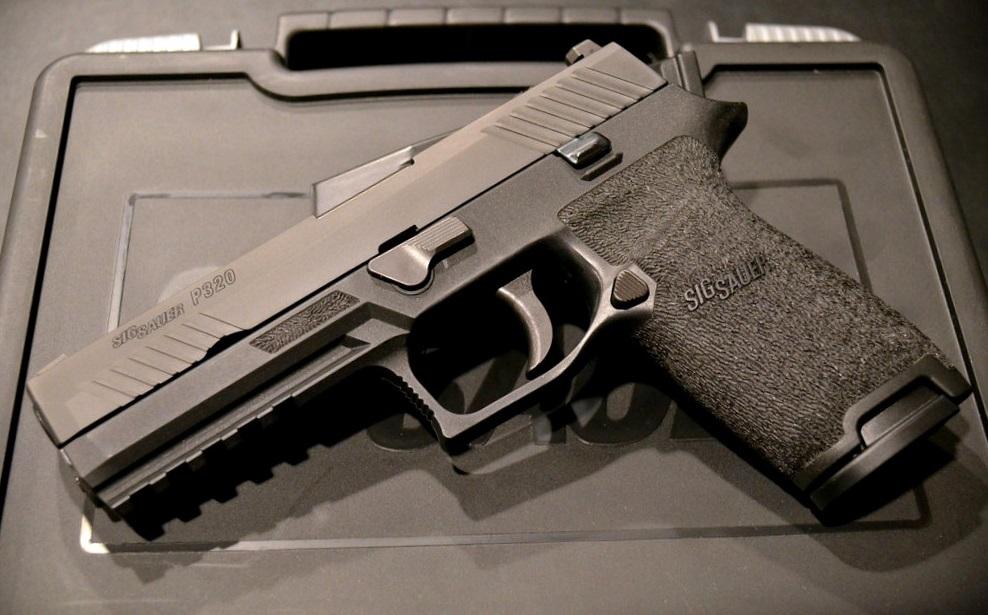Should the ADF jump on the US Army’s modular handgun bandwagon?
Posted By Deane-Peter Baker on March 22, 2017 @ 06:00

Australia is now the last member of the Five Eyes Alliance to commence the process of replacing the venerable—but now obsolete—Browning Hi Power (BHP) as its primary military handgun.
After entering service in 1935, the BHP (or Self-Loading Pistol 9 millimetre Mark 3, to the ADF) became the pistol of the armies of Great Britain, Canada, New Zealand, and Australia. Of the allies which make up the Five Eyes intelligence sharing network , only the United States didn’t adopt the BHP, opting instead for another of John Moses Browning’s designs, the .45 calibre M1911. The British Army farewelled its BHPs in 2013, switching to the Glock 17, which was also selected by New Zealand as its BHP replacement in mid-2016. Last year Canada commenced a process to replacement the BHP, leaving Australia as the only developed nation still arming its conventional soldiers with a WWII vintage sidearm, with no replacement in sight.
We could, however, still beat the Canucks to the punch. According to a Canadian Army spokesperson quoted in Canada’s National Post [1], the requirements for the Canadian Army’s new General Service Pistol (GSP) are likely only to be finalised sometime in 2019 or 2020, with the military expected to seek approval from Canada’s federal government in 2022. Once ordered, full roll out is projected to be complete by 2026, 10 years after the decision to replace the BHP—and that’s only if it doesn’t suffer delays. By then the BHP will have been in military service for 91 years, having been first adopted by Belgium in 1935, with the Canadian Army’s BHPs manufactured between 1937 and 1944 [2].
Canada is not alone in the glacial pace of its procurement program. In January the US Army selected a variant of the Sig Sauer P320 9mm pistol to replace the current Beretta M9 [3] (which is itself a generation ahead of the BHP having been adopted into US service in 1990). The disputed procurement process alone has thus far cost the US taxpayer an estimated $17 million before a single pistol has been purchased. This led the US Army’s Chief of Staff, General Mark Milley, to suggest that the nation would be better served [4] if he were given a credit card with $17 million on it and allowed to place an order with online sporting goods retailer, Cabela’s.
The Australian Army could avoid wasting time and money, and do the right thing by its soldiers [5], by jumping on the MHS bandwagon and ordering the XM17/Sig Sauer P320. The Sig Sauer offers the huge plus (overlooked in the ADF choice of the enhanced F88 rifle over the US issue M4 [6]) of complete interoperability with the handgun selected by our US ally. While the British and NZ armies picked a very capable handgun in the tried-and-tested Glock 17, it’s a conservative choice given that it went into production in 1982 and only minor changes have been made since. The Sig Sauer matches the Glock 17, and adds several more features, including a safety-enhancing loaded chamber indicator and an ambidextrous slide release.
Unlike the Glock, the Sig Sauer can be stripped for cleaning without pulling the trigger, another important safety feature, and the XM17 variant has a thumb safety (also ambidextrous) in addition to its internal safeties, which the Glock does not. But what really sets the XM17/P320 apart is its modularity. On the Glock 17, and the vast majority of other handguns, the frame—the lower part of the gun incorporating the grip and trigger guard—is the core of the system, with most other parts being replaceable. The frame carries the pistol’s serial number, to allow for legal identification.
The dimensions of a pistol’s frame limit its modularity. The genius of the P320 (and similar firearms like the Ruger American Pistol [7]) is that the core of the system is not the frame but rather a serialised metal ‘chassis’ which can be removed from inside the frame allowing a far greater degree of modularity.
This chassis system means that the frame can be quickly and cheaply changed, which allows each gun to be fitted with a grip matching the size of the user’s hands. A full sized P320 can be converted to a compact model, or a long slide model, and back again. New technologies can be integrated as they emerge. Could other handguns be serious contenders? Undoubtedly. But the Sig Sauer would be an excellent choice and, as General Milley said, ‘we are not figuring out the next lunar landing, this is a pistol’. Defence should approach our US allies about jumping on the XM17 bandwagon. Either that, or give General Milley a credit card and send him out shopping.
Article printed from The Strategist: https://aspistrategist.ru
URL to article: /adf-jump-us-armys-modular-handgun-bandwagon/
URLs in this post:
[1] quoted in Canada’s National Post: http://news.nationalpost.com/news/canada/canadian-forces-looking-to-replace-second-world-war-era-pistols-but-it-could-take-another-10-years
[2] manufactured between 1937 and 1944: http://forums.canadiancontent.net/canadian-politics/43311-canadian-troops-using-60-year.html
[3] Beretta M9: https://en.wikipedia.org/wiki/Beretta_M9
[4] General Mark Milley, to suggest that the nation would be better served: http://www.military.com/daily-news/2016/03/10/army-chief-wants-power-to-select-new-pistol.html
[5] and do the right thing by its soldiers: /why-the-adf-handgun-is-an-ethics-issue/
[6] overlooked in the ADF choice of the enhanced F88 rifle over the US issue M4: /sod-the-submarines-can-we-please-talk-about-the-rifles/
[7] Ruger American Pistol: http://www.ruger.com/products/rugerAmericanPistol/models.html
Click here to print.